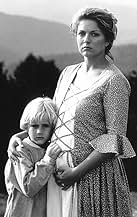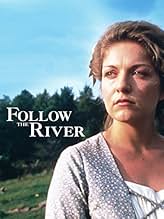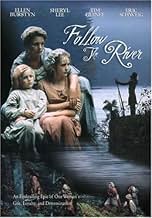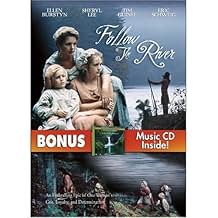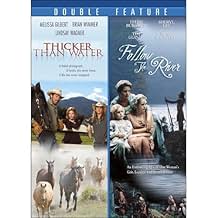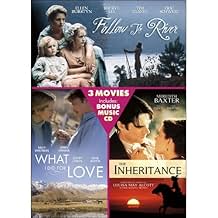अपनी भाषा में प्लॉट जोड़ेंAn "inspirational" true saga of a pioneer woman who is abducted by Shawnee Native Americans in 1755 and finds her way home after 10 years.An "inspirational" true saga of a pioneer woman who is abducted by Shawnee Native Americans in 1755 and finds her way home after 10 years.An "inspirational" true saga of a pioneer woman who is abducted by Shawnee Native Americans in 1755 and finds her way home after 10 years.
- निर्देशक
- लेखक
- स्टार
Andy Stahl
- Henry Lenard
- (as Andrew Stahl)
Stuart Proud Eagle Grant
- Gander Jack
- (बिना क्रेडिट के)
Adrian Roberts
- Casper
- (बिना क्रेडिट के)
फ़ीचर्ड समीक्षाएं
This is one of my favorite movies to watch. I so admire the main character's, Mary Ingles', courage and perseverance under great trial. I had a chance to read the story of the real Mary Ingles that this was based on, and what an amazing lady she was!
Good performances by Sheryl Lee, Eric Schweig, and Ellen Burstyn. Hallmark told this tale without a lot of violence, no profanity, and no trashy sex. This film is well worth seeing.
Good performances by Sheryl Lee, Eric Schweig, and Ellen Burstyn. Hallmark told this tale without a lot of violence, no profanity, and no trashy sex. This film is well worth seeing.
I submitted a review not long ago, but I don't think it was accepted because I had a lot of political commentary about not so politically correct stuff.
In 1985, when I was 14 years old, my mother came into my room and handed me a paperback book called FOLLOW THE RIVER. "This is the most INSPIRING story I've read in a long long time." I, not being much of a reader at that age, took this book, and COULD NOT PUT IT DOWN!!!
It is, to this day, my all time favorite novel. That they made a little TV movie based on this wonderful work was bad enough. They should have made an epic feature film about the unforgettable protag and her true story. But to make a TV movie that squishes 5 months in a woman's life into 2 commercial ridden hours, and sanitizes the facts too??? Foul!!!
Mary Draper Ingles was a young mother of three. Her third baby was actually due to be born any day. On July 8, 1755, Shawnee Native Americans raided her settlement in Virginia, killed many of her neighbors, and even killed her mother. Then they abducted her, her two little boys, her sister in law Bettie, and a neighbor named Lenard, and took them from Virginia, up into W. Virginia thru the New River Gorge, on to the mighty Ohio River, and into Southern Ohio (present site of Portsmouth). Mrs. Ingles' life is scattered, devastated and all but destroyed. Eventually, in a few weeks as a captive, she loses her family. Her sons are adopted and taken to still another faraway Shawnee settlement. Bettie is given as a wife to a Shawnee man, and Mary herself is sold to French traders, along with a new friend, Ghetel, an elderly Dutch widow. Her life further ruined and disrupted, she makes a fateful decision: either return home to Virginia and to her husband William, or life is not worth living. Will is all she has left to remind her of who she truly is. She must return to him.
The movie devotes a mere 20 mins. to Mary's 1000 mile walk home. The book is so much more fun to experience, so rich in detail, and author James A. Thom constantly lets you inside Mary's head to know her thoughts, fears, regrets. She decides she must abandon the baby girl she had en route to her slavery. A Shawnee woman has pretty much taken over the baby anyway.
In September 1755, Mary and the elderly Dutch woman Ghetel escape while on a salt making assignment at the Big Bone Lick in western Kentucky, even father from home than the town in Southern Ohio, and from western Kentucky, through Southern Ohio, through W. Va and the formidable New River Gorge, formed through the centuries into tall, dark, rocky palisades that Mary, who has been weakened, starved and fatigued by her travels already, is forced to CLIMB in order to reach her husband. On top of this, it is already wintertime.
None of these wonderous facts are in the movie. Instead, we are given a completely fictitious segment at the end. It just seems all watered-down, sanitized, politically correct. The ending of the movie is NOTHING AT ALL like the one in the book. Mary's two sons were taken from her. Her younger boy died right after he was taken from his mother. Thirteen years passed before Mary laid eyes on the older son again. The baby daughter was NOT BROUGHT BACK TO MARY BY CAPT. WILDCAT. The baby daughter was adopted by a Shawnee woman and never seen by her natural mother again. The ending of the TV movie was like a politically correct fairy tale.
Because of the depression, the emotional toll the events took on Mary Ingles' life, her hair turned prematurely white at the age of 23. But thankfully, she did return to her husband William, she did recover from her malnutrition, and she had four more children. In 1768, she and her oldest son, Thomas, who was 5 when she saw him last, were reunited after he was ransomed. Bettie Draper, who was given to be the wife/concubine of a Shawnee man, was also ransomed, but died at the young age of 42, doubtlessly having never fully recovered from her ordeal.
Fact: Life isn't fair. Bad things happen to good people. Things don't always end up well and fine. The history of this country is not a fairy tale.
In my opinion, if you're afraid of not being politically correct in telling the facts, don't make the movie.
In 1985, when I was 14 years old, my mother came into my room and handed me a paperback book called FOLLOW THE RIVER. "This is the most INSPIRING story I've read in a long long time." I, not being much of a reader at that age, took this book, and COULD NOT PUT IT DOWN!!!
It is, to this day, my all time favorite novel. That they made a little TV movie based on this wonderful work was bad enough. They should have made an epic feature film about the unforgettable protag and her true story. But to make a TV movie that squishes 5 months in a woman's life into 2 commercial ridden hours, and sanitizes the facts too??? Foul!!!
Mary Draper Ingles was a young mother of three. Her third baby was actually due to be born any day. On July 8, 1755, Shawnee Native Americans raided her settlement in Virginia, killed many of her neighbors, and even killed her mother. Then they abducted her, her two little boys, her sister in law Bettie, and a neighbor named Lenard, and took them from Virginia, up into W. Virginia thru the New River Gorge, on to the mighty Ohio River, and into Southern Ohio (present site of Portsmouth). Mrs. Ingles' life is scattered, devastated and all but destroyed. Eventually, in a few weeks as a captive, she loses her family. Her sons are adopted and taken to still another faraway Shawnee settlement. Bettie is given as a wife to a Shawnee man, and Mary herself is sold to French traders, along with a new friend, Ghetel, an elderly Dutch widow. Her life further ruined and disrupted, she makes a fateful decision: either return home to Virginia and to her husband William, or life is not worth living. Will is all she has left to remind her of who she truly is. She must return to him.
The movie devotes a mere 20 mins. to Mary's 1000 mile walk home. The book is so much more fun to experience, so rich in detail, and author James A. Thom constantly lets you inside Mary's head to know her thoughts, fears, regrets. She decides she must abandon the baby girl she had en route to her slavery. A Shawnee woman has pretty much taken over the baby anyway.
In September 1755, Mary and the elderly Dutch woman Ghetel escape while on a salt making assignment at the Big Bone Lick in western Kentucky, even father from home than the town in Southern Ohio, and from western Kentucky, through Southern Ohio, through W. Va and the formidable New River Gorge, formed through the centuries into tall, dark, rocky palisades that Mary, who has been weakened, starved and fatigued by her travels already, is forced to CLIMB in order to reach her husband. On top of this, it is already wintertime.
None of these wonderous facts are in the movie. Instead, we are given a completely fictitious segment at the end. It just seems all watered-down, sanitized, politically correct. The ending of the movie is NOTHING AT ALL like the one in the book. Mary's two sons were taken from her. Her younger boy died right after he was taken from his mother. Thirteen years passed before Mary laid eyes on the older son again. The baby daughter was NOT BROUGHT BACK TO MARY BY CAPT. WILDCAT. The baby daughter was adopted by a Shawnee woman and never seen by her natural mother again. The ending of the TV movie was like a politically correct fairy tale.
Because of the depression, the emotional toll the events took on Mary Ingles' life, her hair turned prematurely white at the age of 23. But thankfully, she did return to her husband William, she did recover from her malnutrition, and she had four more children. In 1768, she and her oldest son, Thomas, who was 5 when she saw him last, were reunited after he was ransomed. Bettie Draper, who was given to be the wife/concubine of a Shawnee man, was also ransomed, but died at the young age of 42, doubtlessly having never fully recovered from her ordeal.
Fact: Life isn't fair. Bad things happen to good people. Things don't always end up well and fine. The history of this country is not a fairy tale.
In my opinion, if you're afraid of not being politically correct in telling the facts, don't make the movie.
A few years ago, I was at a pub in Santa Monica, CA. Having a beer and reading John Irving's "A Prayer for Owen Meaney". A man was sitting next to me and we struck up conversation about the book, and if it could be made in to a movie (Which, sad to say, it sort of was in the guise of "Simon Birch", another book ruined by Hollywood, but I digress)This man then asked me what great book I had read which I thought would be a great movie, and I said "Follow the River". I explained the story to him (Mari's review is great)and even that I would cast Eric Schweig as Wildcat. Less than a year later, viola, this god-awful movie shows up on television (and I don't think it was a coincidence). This book is so beautiful, a tale of strong will and courage, overcoming great odd's. And it's turned into American-pie everyone lives happily ever after fodder. Why must Hollywood take wonderful books and ruin them. If it ain't broke, don't fix it!
Follow The River was the best book I have ever read, and knowing it was a true story made it even more interesting. It has been about a year and a half since I read the book and I was quite excited to learn that the story had been made in to a movie. Even though the movie had been around since 1995 I didn't know it existed. The movie was quite a disappointment. From what I read in the book, Mary Ingles appeared to be a strong, passionate, brave and courageous woman. I don't understand why some of the events of the story were changed in the movie. There was no need for changes.Why didn't the script stick to the story just as it happened. It was a true life event---not a work of fiction. More time should have been given to her journey home. So much was left out. I don't think the acting was strong enough either. Maybe some day there will be a remake with actors that will fit the roles and it will be in the movie theaters so it will include many of the events that were left out and give more time to the journey back home.
Several years ago I read this book. I loved the book. So when I saw it was on TV this afternoon I decided to watch it.
I know that books are nothing like the movie and movies are never like the book but after 30 minutes I had to turn this drivel off.
It was bad enough that it is not accurate to the book or even history but the fact that everyone looked like a character from a romance novel just sent me over the edge.
Just a bad bad movie. Not even worth writing anymore about.
But it is seems I have to write more to get this posted! It amazes me that people will take the time & money to make movies based on books and then just take the title and character names. This movie is a great example of why if you are to read the book you can't get away with watching the movie!
I know that books are nothing like the movie and movies are never like the book but after 30 minutes I had to turn this drivel off.
It was bad enough that it is not accurate to the book or even history but the fact that everyone looked like a character from a romance novel just sent me over the edge.
Just a bad bad movie. Not even worth writing anymore about.
But it is seems I have to write more to get this posted! It amazes me that people will take the time & money to make movies based on books and then just take the title and character names. This movie is a great example of why if you are to read the book you can't get away with watching the movie!
क्या आपको पता है
- ट्रिवियाBased on the Massacre at Draper Meadows July 8 1755.
- गूफ़In the scene in which Mary, Tommy and Betty are welcomed into the lodge with the Shawnee woman, Mary confides that she has little breastmilk for her newborn baby (likely due to malnutrition while in captivity). The woman gives her fennel seeds, which Mary then appears to feed directly to the baby. Seeds of any sort are never safe to feed to an infant. While fennel promotes lactation and eases colic, the best utilization is either the mother eating them or making a tea to give to the baby in very small doses.
टॉप पसंद
रेटिंग देने के लिए साइन-इन करें और वैयक्तिकृत सुझावों के लिए वॉचलिस्ट करें
विवरण
इस पेज में योगदान दें
किसी बदलाव का सुझाव दें या अनुपलब्ध कॉन्टेंट जोड़ें

